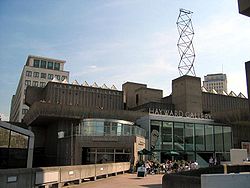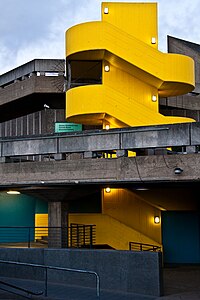Hayward Gallery
| Hayward Gallery | |
|
Surrey | |
|---|---|

| |
| Type: | Art gallery |
| Location | |
| Grid reference: | TQ30908028 |
| Location: | 51°30’23"N, 0°6’55"W |
| Town: | Lambeth |
| History | |
| Built 1968 | |
| By: | Norman Engleback Ron Herron and Warren Chalk |
| Art gallery | |
| Brutalist | |
| Information | |
| Owned by: | Southbank Centre Ltd |
| Website: | Hayward Gallery: Southbank Centre |
The Hayward Gallery is an art gallery within the Southbank Centre, part of an area of major arts venues on the south bank of the River Thames in Lambeth, Surrey. It is sited adjacent to the other Southbank Centre buildings: the Royal Festival Hall and the Queen Elizabeth Hall/Purcell Room) and also the Royal National Theatre and to the British Film Institute.
Following a rebranding of the South Bank Centre to become 'Southbank Centre' in early 2007, the Hayward Gallery was known as 'The Hayward' until early 2011. It is named after Sir Isaac Hayward, the Monmouthshire miner's son who was leader of the London County Council for 18 years until its abolition, who drove the project to build the Royal Festival Hall.[1]
The gallery was opened in 1968. It was built at the same time as the Queen Elizabeth Hall (which opened in 1967) and in the same, uncompromising brutalist style. The two are regarded with some justification as the ugliest public buildings on the river.
The gallery was temporarily closed in September 2015, for two years of renovations.[2]
Description
The Hayward Gallery was built by Higgs and Hill[3] and opened on 9 July 1968. Its massing and extensive use of exposed concrete construction are typical of Brutalist architecture. The initial concept was designed, with the Queen Elizabeth Hall and Purcell Room, as an addition to the Southbank Centre arts complex by team leader Norman Engleback, assisted by Ron Herron and Warren Chalk, two members of the later founded group Archigram, of the municipal Department of Architecture and Civic Design. Chalk then developed the site plan and connective first floor walkways, while Ron Herron worked on the acoustics for the Queen Elizabeth Hall. Alan Waterhouse, then Dennis Crompton, worked on the designs for the Hayward. Joanna Drew was the founding Director.
Exhibitions
The Hayward hosts three/four major temporary modern or contemporary exhibitions each year and does not house any permanent collections. From 1968 to 1986, the gallery was managed by the Arts Council of Great Britain, but management then passed to Southbank Centre. The gallery is also the base of the Arts Council's National Touring Exhibitions programme, as it was, until 2002, of the Arts Council Collection. Unlike British galleries receiving state funding support, but in common with other temporary exhibitions at British galleries, the Hayward charges admission fees. The Hayward's exhibition policy embraces visual art from all periods, and past shows have included the works of Leonardo da Vinci, Edvard Munch and the French Impressionists. Recently the programme has tended to concentrate on surveys of contemporary art which complement the spaces and powerful concrete structure of the building, such as those of works by Dan Flavin and Antony Gormley.
It has hosted two surveys of works from the Arts Council Collection: British Art 1940–1980 and How to Improve the World: 60 Years of British Art.
Architecture
The design brief was for five gallery spaces, two levels of indoor galleries and three outdoor sculpture courts (the massive concrete trays at the upper level) in order to house the Arts Council collection. The intended outdoor display of sculpture against the background of the London skyline appears to have been impractical and the sculpture courts have been little used and usually closed to the public until the Blind Light exhibition of works by Antony Gormley in 2007.
The two levels of the gallery open to the public are linked by a pair of cast concrete staircases. These staircases, and lavatories at an intermediate level, are accommodated in a concrete box in between the eastern and western parts of the indoor galleries. One of these staircases also runs down to street level with access (now emergency only) to Belvedere Road; the other extends down into the private entrance foyer, at lower level, on the north side of the building. This almost hidden private entrance is located below the foyer and external walkway on the north facade, above the car park and near the overhanging Purcell Room auditorium. The screens advertising the British Film Institute and Museum of the Moving Image which enclosed the car park by the central access road were removed in 2008, giving a more open feel to the ground level area at the west end.
The building originally had a very small main foyer area with cast aluminium doors similar to those of the Queen Elizabeth Hall. In 2003, the foyer of the building was remodelled with a larger glass-fronted foyer, designed by the Haworth Tompkins architectural practice, and including a new oval shaped glass pavilion designed by Dan Graham above a new cafe in the projecting former office space at the east end. A shop had been added earlier inside the north-west end of the lower gallery.
The two upper galleries can use heavily filtered natural light from the glass pyramids on their flat roofs. Three concrete towers run vertically through the middle of the structure and contain the passenger lift, service lift and service duct. Between 1972 and 2008 a kinetic light sculpture, which responds to wind force, stood on the roof of the passenger lift tower. This famous London landmark was designed and built by Philip Vaughan and Roger Dainton [4] as a way to attract visitors to the gallery. It was removed in order for renovation to take place[5] which involved replacing the original neon lighting with LEDs,[6] but subsequently a decision has been taken not to reinstall it.[7]
The roof terrace at the south end and linking bridge to the Queen Elizabeth Hall foyer building is closed to the public, which makes impossible some of the more interesting pedestrian circulation opportunities of the original design, although these have been opened for the Summer of Fun festival in 2011.
The walkway above Belvedere Road with access from Waterloo Bridge widens to the west, following the line of Belvedere Road and accommodating the stairs to the external terrace, but following a different line from the upper gallery walls. The angled plan shape of the concrete sculpture court in the south corner reflects the change in angle of the site between Waterloo Bridge and Festival Square. In this way, despite its seemingly uncompromising form, the building responds to its site.
The south-west corner of the building at street level is occupied by an electrical switch room. A car park occupies most of the lower ground level. A plant room occupies the lower level at the east end, above the car park, with a great concrete exhaust stack by Waterloo Bridge.
The high-level walkway system which linked the Hayward to the Hungerford Bridge area was partly removed in spring 1999, leaving a curious truncated end on Festival Square, and poorer access from Festival Square. This is exacerbated by the positioning of the car park and loading bay entrances, a legacy of the original 1960s design ideas about vertical separation of pedestrian and vehicle traffic. Among the tricks of the building is the different lines of the walls at ground level and walkway level on this facade, which reconcile the differing axes of the Hayward and the Royal Festival Hall.
In 2011, the Hayward Gallery was added to the protected list by the World Monuments Fund, despite being refused listed building status.
Future
Southbank Centre and Arts Council are considering the future of the Hayward building, together with the Queen Elizabeth Hall and Purcell Room which stand between the Hayward and the River Thames. A proposed scheme selected from an architectural competition, designed by Richard Rogers, in the early 1990s would have involved covering all three buildings in a great wave-shaped glass roof, which would have linked the Royal Festival Hall to Waterloo Bridge. This did not proceed due to its reliance on a high level of lottery funding, likely high cost, and the opposition of the Twentieth Century Society who saw it as damaging to the setting of the individual buildings underneath the canopy.
Outside links
- Hayward Gallery: Southbank Centre
- Hayward Gallery at Google Cultural Institute
- Arts Guardian (Article on Ralph Rugoff, Director of the Hayward)
- Saatchi Gallery blog (Interview with Ralph Rugoff)
- Haworth Tompkins architectural partnership (Architects of new foyer, of 2003, photographs under Built Works)
- Institute of International Visual Arts (Collection and access information)
- Artfacts.Net (General information)
- Flickr group dedicated to pictures of the Southbank Centre
References
- ↑ Facts About London accessed 02/01/08
- ↑ Ellis-Petersen, Hannah (7 August 2014). "Hayward gallery to host UK's first Carsten Höller retrospective". The Guardian. https://www.theguardian.com/artanddesign/2014/aug/07/hayward-gallery-uk-first-carsten-holler-retrospective. Retrieved 24 November 2016.
- ↑ Crown Works Vauxhall Civic Society
- ↑ https://www.codaworx.com/project/neon-tower-hayward-gallery-arts-council-of-great-britain
- ↑ http://www.philipvaughan.net/art/35.htm
- ↑ http://www.sculpture.org/portfolio/sculpture_info.php?sculpture_id=1011935
- ↑ http://www.telegraph.co.uk/culture/art/art-news/9939621/Hayward-Gallery-Neon-Tower-artist-is-angered-by-removal.html
- ARUP Journal: South Bank Arts Centre; Architects: H. Bennett, Greater London Council chief architect 1967 July, pp. 20–31
- Architectural Review: South Bank Arts Centre, London borough of Lambeth; Architects: H. Bennett, architect to the Greater London Council vol. 144, no. 857, 1968 July, pp. 14–30
- Interior Design: Hayward Art Gallery, South Bank Art Centre, London; Architect: H. Bennett, architect to the Greater London Council 1968 September, pp. 49–54
- Official Architecture & Planning : South Bank Cultural Centre, London borough of Lambeth; Architect: H. Bennett, chief architect of the Greater London Council 1969 August, pp. 918–923
- The Architects' Journal: No. 3441, Vol. 133. 30 March 1961, pp. 469–478
